In last month’s issue I highlighted the need to carry sufficient spares, choosing the best weight of fly rod for the job at hand, as well as the need for a thorough pre-use service of reels that are likely going to be in a harsh environment for an extended time. This month, I will also offer some more hints on tackle care when fly fishing in tropical environment and some fishing tactics as well.
With a cast being made every couple of minutes, the fly line needs extra TLC. There are two things in the tropical environment very likely to damage it - and it can occur in the boat or when fishing from the shore. The first culprit is insect repellent and the second is sunscreen. Any exposure to either is going to see the fly line wrecked in short order with cracks or chafing evident, even the plastic coating dissolving from some of the powerful tropical strength insect repellents or SPF 50 sunscreens available. Use them, by all means, but wipe the hands very carefully after use. I keep a separate cloth for this, not the one with slime and scales all over it from yesterday, this can make things very smelly.
Take a few minutes at the end of a day’s fly fishing to wash both the rod and the fly line to rid them of salt water, even running the fly line through a wet rag will serve to check out any damage and also get rid of salt from the line and reel.
Finally, be extra careful when fishing from the shore over bits of coral, small stones and lumps of pumice stone, as all can damage a fly line that’s suddenly being lifted from the ground to complete a ripper of a forward cast.
It won’t take long when flyfishing in the tropical environment to discover that things happen mighty quickly up there. The sheer speed of fish such as the trevally species, queenfish, barracuda, tarpon as well as giant and wolf herring as they work a shore line or mangrove edge means that the swirl or splash suddenly catching the attention is usually going to be some distance behind the fish that made it. The trick is to quickly get the fly into an area 4-5m ahead of the splash and strip it as fast as possible for these speedsters. Then, when a fish wallops the fly, don’t instinctively lift the rod; give the line a smart strip-strike. Next, as the strain comes on, kick the rod to the side rather than upwards; lifting the rod will often cause a lot of these finned rockets to jump and throw the hook.
I must clarify that barra and mangrove jacks demand different tactics. These are ambush feeders so you need to present the fly straight to them instead. The only thing to come to terms with in this scenario is just how close, how very close you can get to a barra or jack that is perfectly willing to take a fly, so long as some degree of stealth is used. I’ve seen barra and jacks grabbing a fly one rod’s length from the boat in around 40-50cm of water with the electric motor humming hard against tidal flow. Drifting is naturally brilliant, and will be one of the best approach tactics, but not always the best choice because the speed of the drift can cause fly line management issues.
Deciding just where to fish on a bank that all looks good can be tricky, so we will look at a couple of scenarios. We will first look at the beach. It’s brilliant to see fish working the shoreline but you need to understand that no matter how few anglers these fish have seen, they will still not tolerate a clumsy or rushed approach, or even a shadow from a clear fly line going over them. Keeping low, ducking away from the water and sneaking ahead of the fish to allow them to approach rather than chasing them will pay off. Also, be aware that fish, even quite large ones, may only present as mere shadows. If a shadow is moving, call it for a fish and cast ahead of it!
Another common scenario is rock bars or mangrove bank. These are among my favourites as they can harbour some real talent, so far as hard chargers go. Rock bars look great but are often too good in some respects with a lot of areas for fish to hide. The trick is to work a deeper bit of water adjoining the bar on the downstream side of it and lock the reel as soon as a bite registers. Fishing right up top of a bar and hooking a fish will usually lead to a shredded fly line. It might be fun at first, but not funny in the end.
Mangrove banks with snags extending into some depth are tricky. You’ll look at them and think, “Where to start?” The answer is, right where the first snags associated with those mangroves are standing against tidal flow. Find this place and you will find the fish. Whether the tide is making or ebbing won’t matter, it’s the location that matters so it’s important to get the fly to sneak along the edge of the chosen feature with the current. Nothing ambush feeders eat will move much against current, so the fly should move with current flow.
Another hot spot can be anywhere along a mangrove bank where snags appear to be free standing away from the main bank so long as the water is not too deep, which makes getting a fly on an intermediate sink line (my choice for this style of fishing) down into the likely strike zone more difficult.
When working a section of bank from a boat, remember that it’s vital to keep any belly or bow that is being caused by current to a bare minimum. Adjusting boat travel to minimise belly and slack is vital to keep in touch with the fly at all times or fish will be felt but missed.
We all understand that flies need to represent bait fish but far northern bait fish are often dull coloured, and a fair bit less shiny than the sort of bait (herring, hardiheads, pillies) we see further south. Flies on size 2/0 or even 1/0 hooks are usually accepted readily, especially if they are a little on the dull side with brown or olive coloured backs. Be prepared to downsize. If fish such as trevally or queenies are charging the fly but not actually hooking up, then changing to a smaller fly will usually see success at the next cast.
Poppers can be fun. The best popper fishing seems to be at times of low light when fish are attracted to a splash but don’t get a good look at what is making it. Again, a definite strip-strike is required to set the popper into a hard jaw.
Last but not least, never be put off by the fact that tidal flow has made the water somewhat discoloured. Tropical fish will feed readily in such water and pick up the movement of a small fly with ease. That’s one of the really great things about flyfishing in the far north; clear water is optional and not near as important as it is further south.
Reads: 2800
Barra off the beach. Scott Kampe caught this fish when it appeared as a mere shadow out wide.
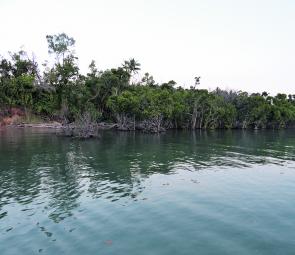
In this scenario the first snags encountered are usually some of the best to fish with the fly.

Was that a splash there? Evening in the gulf is a mighty good time for a hook-up on fly.
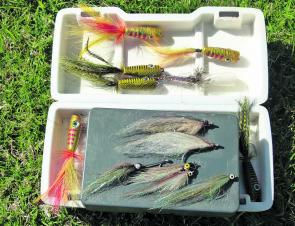
Note the dull colour of this selection of flies for the tropics. Poppers work best when the light is down.
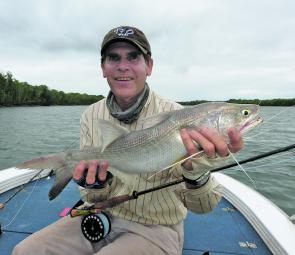
Discoloured water is not a bar to success in the tropics. This little thready held by the author came out of 40cm of quite dirty water.
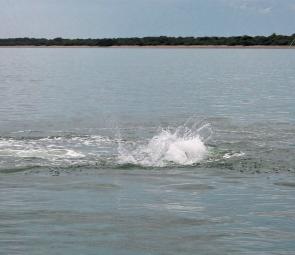
Hookup as a big queenie whacks the fly.

Rock bars certainly hold fish but beware of fishing too close to line-damaging territory.

Fishing the beach is fun but the immediate environment under foot can cause damage to the fly line.
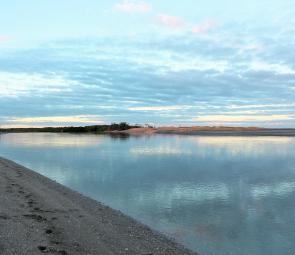
The best of it. Early morning on a deserted tropical beach.

A small camp and a beautiful beach to fish, that’s a great combination and part of northern flyfishing.




